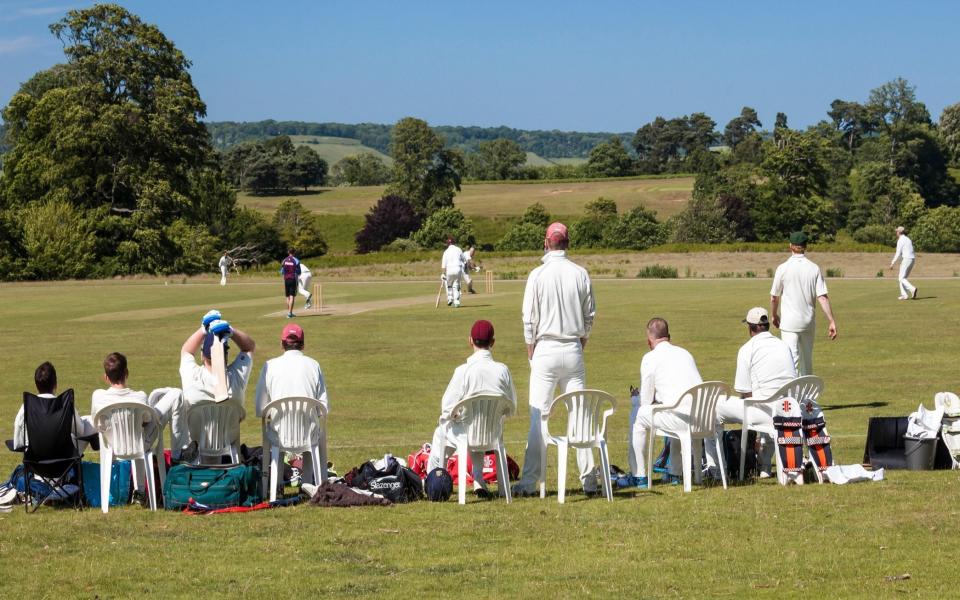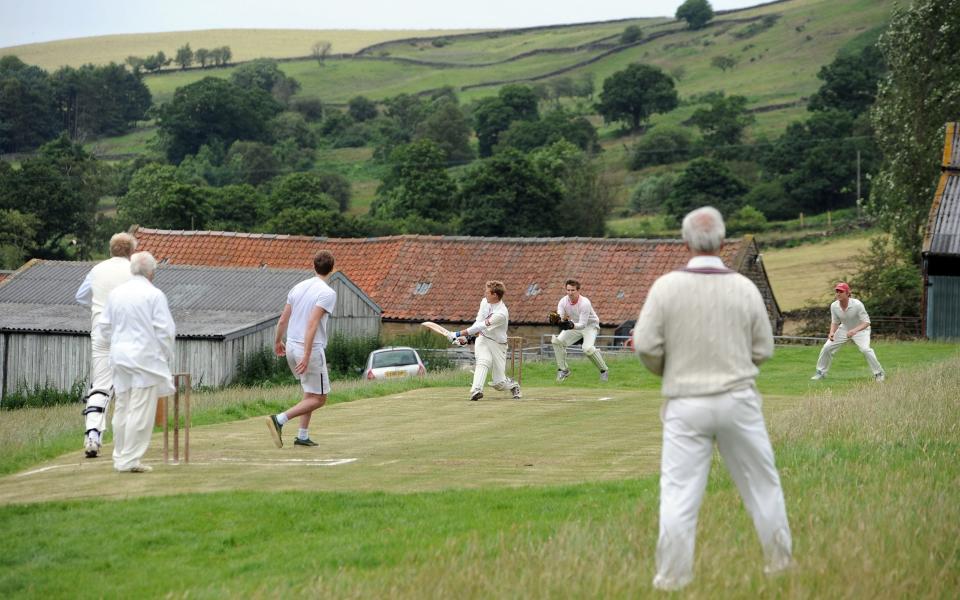The curious etiquette of village cricket

To the casual observer – blessedly ignorant of the unwritten mores and customs of our nation’s summer sport – it might be hard to see what the problem was. Last week, a gentleman by the name of Rikki Clarke, playing for Shrewton Cricket Club in Division Two of the Hampshire League, put the South Wilts 3rd XI to the sword. He scored 229 off 109 balls, including 22 sixes, and helped his team reach a mighty 385 for seven off just 45 overs.
Well done him, you might say, an impressive performance worthy of a polite round of applause from a handful of spectators and perhaps an extra scone at tea. The problem was that Clarke is more than just a bit handy. He’s a former Surrey allrounder who only recently retired from playing professional cricket. Indeed, he even played for England’s Test and one-day sides a few times in the Noughties.
Clarke is therefore, in cricketing terms, a god who has casually sauntered down the pavilion steps from Mount Olympus to amuse himself for a brief portion of eternity by interfering in the affairs of mere mortals. When he posted about his performance on social media, the former pro was met with a backlash of vitriol. Scyld Berry, the Telegraph’s chief cricket writer, described Clarke as a shark swimming in a goldfish bowl and argued that such bullying of club players was against the spirit of cricket.
Is it? It’s often assumed that laws – not rules – of cricket were etched in the same honey-coloured stone with which the Victorians constructed the pavilion at Lord’s and are similarly immutable. But in reality they have developed organically over time and continue to do so in order to maintain parity in the never-ending tussle between batters and bowlers. The “spirit of the game” is even more amorphous, referring as it does to cricket’s mores and customs, especially at the lower echelons.
The only sin comparable to that of taking village cricket too seriously is that of not taking it seriously enough. This is, after all, a pastime to which its practitioners will devote a not insignificant proportion of their waking hours throughout the summer – not just playing but also preparing the pitch, keeping the score, maintaining the pavilion and such like. As with all sports, cricket invokes deep passions that are probably all the more keenly felt for their obvious absurdity. Players must therefore navigate a minefield of unwritten dos and don’ts that vary from club to club and are shaped by local customs, characters, climate, geography, flora and fauna.

Almost by definition, any attempt to catalogue such rites and rituals will be incomplete but some are more common than others. Many cricket grounds will, for example, have a tree or two growing inside the boundary rope (there’s one at Blackheath Cricket Club near Guildford in Surrey where I’ve just started to play) and local rules to decide how many runs are scored if the ball hits it after bouncing, on the full or when thrown into its branches by a malcoordinated fielder.
The Ship Inn Cricket Club in East Neuk, Fife plays all its home matches on Elie Beach. The boundary on one side will shorten as the tide comes in and players can win their height in beer if they hit the ball directly into the pub. The fallow deer have right of way at Sennocke Cricket Club, in Knole Park, Kent, and play will pause if a particularly delicious patch of grass at long off catches their eye. Spout House Cricket Club in North Yorkshire is situated on a working sheep farm with a one-in-seven slope, presumably making it very easy to score fours on one side of the wicket and nigh-on impossible on the other.
Whereas first-class players will run from the pitch and call for the covers at the faintest hint of moisture in the air, village players, who may well have driven many miles to an away match, will soldier on in almost any weather milder than biblical.
Poor captaincy and general decrepitude can often lead to unusual field settings. Many village sides will utilise a long stop to sweep up all the balls their creaky wicketkeeper lets through. Captains spend a lot of time trying to “hide” their worst fielders who inevitably become ball magnets. Players tend to be placed in the slips not because of their ability to catch but rather because of their inability to run or throw – or both.
If there are kids playing it is generally accepted that the batters won’t spank their bowling all over the place and bowlers won’t pitch it short to them. Having been paid this consideration, the little blighters often turn out to be the worst sledgers.

Those with kit are more or less obligated to share it with the have-nots. However, it’s a bit off to ask to borrow someone’s box, but okay to hide your new blade behind the pavilion because it isn’t properly “knocked in” yet. The more matching logos you have on your equipment, the more like a sponsored pro you look, the higher the expectations of your performance and more you will be ridiculed when you clatter into your own stumps after being unbalanced by missing a mighty hoick into cow corner (so called either because it's a supposedly safe spot for cattle to graze because very few batsmen would hit the ball there or because the type of shot required to do so could best be termed “agricultural”).
The most contentious area of cricket is, of course, the leg-before-wicket law, as this requires a judgement from the umpire about whether a ball that has struck the pads would go on to hit the stumps (and whether it has pitched outside leg or hit the pad outside off without a shot being offered, and so on and so on – there are ten subclauses to this particular law). At the top level the controversy is somewhat negated by Hawk-Eye technology which accurately tracks the flight of the ball. At the village level it is exacerbated by the fact that umpires are almost always members of the batting side, who are hopelessly biased and have enough on their plate trying to count up to six to remember when the over should finish.
The default position tends to be that no one is ever out and umpires have to cycle through a series of stock excuses for turning down the increasingly frantic appeals – “it was going down leg”, “too high”, “too far forward”. But occasionally they will give a teammate out – whether they are or not – if they are scoring too slowly or to settle some ancient grudge. A true sportsman will know if he’s been hit plum in front of the stumps and “walk”, unless, of course, the result is still in the balance.
Those players that do well – by, for example, scoring 50 or taking five wickets – are naturally punished for their efforts and made to buy a jug of beer for their teammates. Those that get out with a score in the high 40s are assumed to have done so on purpose to avoid buying said jug and therefore made to do so anyway on the grounds of so-called “jug avoidance”.
Which brings us back to the tricky question of whether you can be too good for village cricket. I co-host the Telegraph’s Vaughany and Tuffers Cricket Club podcast with former England players Michael Vaughan and Phil Tufnell (out now on all good podcast apps!).
To get to the bottom of the Rikki Clarke controversy we contacted the man himself.
He told us that he first came across Shrewton when he was looking for somewhere his son could play. He has since – as is so often the danger – been fully sucked into club life and has helped out jet-washing the deck, coaching the juniors and even scoring for the 2nds on occasion. In other words, Clarke is a man that is fully embracing (or has been fully embraced by – it’s never fully clear whether you choose or are chosen) village cricket.
He is not just some ex-pro ringer who has turned up in a shiny car covered in sponsor stickers to unsheath his custom-made, thick-edged bat and cause mayhem before roaring off as soon as his innings is over. As he points out, this was his fourth innings for the side and he previously scored 14, 14 and 41. He bowls off a shortened run-up. And he thinks the best way to ensure the club flourishes is to make sure the side wins. If nothing else, he’s certainly put Shrewton on the map.
Many clubs are struggling for numbers these days. It would be nuts if they turned away players for being too good. Isn’t it great that a bunch of village cricketers are getting the opportunity to play with and against an ex-pro? Isn't that a good way to nourish the grass roots?
Whatever your views there can be little doubt that Clarke has added one more thread to cricket's rich tapestry of anecdotes and folklore. That said, my thoughts and prayers are with the bowlers in Division Two of the Hampshire League.
Does your cricket club have an unusual rule or custom? Email Ben at cricketclub@telegraph.co.uk
Listen to The Vaughany and Tuffers Cricket Club on the audio player above, at telegraph.co.uk or your favourite podcast app
10 cricket grounds that push the boundaries
1. Epping Foresters Cricket Club, Essex
Settled in London’s greenbelt, it’s hard to believe that the soil is only 18 inches deep and the M25 is buzzing just underneath the crease. Initially the motorway was planned to plough right through the pitch but after a feat of Eighties engineering, a deep cut and cover tunnel was created allowing a ground to be reinstated.
2. Lynton and Lynmouth Cricket Club, Devon

Set among the Valley of the Rocks in north Devon, cricket here is played with Exmoor’s dramatic coastline as the backdrop alongside stunning views across the Bristol Channel and the occasional feral goat.
3. St Lawrence Ground, Canterbury
When this ground opened in 1847, it was designed around an existing lime tree which sat right on the pitch and necessitated special rules (shots blocked by the tree counted as a four). It sadly blew down in 2005 and a replacement lime has since been planted – still inside the playing area but outside the boundary ropes.
4. Abinger Cricket Ground, Surrey
You couldn’t ask for a more quintessentially English setting for a cricket ground; a village green sat in an unspoilt village in the Surrey Hills, an Area of Outstanding Natural Beauty. Chocolate box doesn’t cover it.
5. Bournville Cricket Club, Birmingham
The Bournville cricket pavilion was one of the first buildings to be completed in George Cadbury’s plan for his model village and now overlooks the efforts of the Bournville Cricket Club.
6. Stoneleigh Cricket Club, Warwickshire
The west wing of Stoneleigh Abbey has been the backdrop of nearly two centuries of cricket as it was its owner, Edward Chandos Leigh (and later president of the MCC) who founded the Stoneleigh Cricket Club in 1839.
7. The Ship Inn Cricket Club, East Neuk Fife

The flat, sandy stretch of Elie beach serves as a cricket ground – making it the only club in the world to play at the seaside. The team can only turn out at low tide in the afternoon, every other weekend, and must wait three hours after high tide for the sand to dry off. A rubber ball is required to muster up any sort of bounce.
8. Sennocke Cricket Club, Knole Park, Kent
Members of the 350-strong wild deer herd are known to wander onto the pitch here and as they have right of way, play has to stop until they’ve wandered off again.
9. Spout House Cricket Club, North Yorkshire

Untamed grass and a 14 per cent gradient are just two of the oddities at this rural ground. Set among prime sheep-farming land (the sheep are ushered elsewhere on match days), the dry stone walls set the boundaries and there’s a Victorian sandstone roller on site to smooth out the worst of the hoof damage.
10. Bridgetown Cricket Club, Somerset
Wisden has named this the loveliest cricket club and few could argue. Its clubhouse is timbered with a thatch roof and the ground itself sits on a bend on the River Exe, surrounded by lush woodland.

 Yahoo Sport
Yahoo Sport 





































